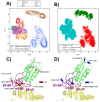Singular Interface Dynamics of the SARS-CoV-2 Delta Variant Explained with Contact Perturbation Analysis
- PMID: 35754360
- PMCID: PMC9199437
- DOI: 10.1021/acs.jcim.2c00350
Singular Interface Dynamics of the SARS-CoV-2 Delta Variant Explained with Contact Perturbation Analysis
Abstract
Emerging SARS-CoV-2 variants raise concerns about our ability to withstand the Covid-19 pandemic, and therefore, understanding mechanistic differences of those variants is crucial. In this study, we investigate disparities between the SARS-CoV-2 wild type and five variants that emerged in late 2020, focusing on the structure and dynamics of the spike protein interface with the human angiotensin-converting enzyme 2 (ACE2) receptor, by using crystallographic structures and extended analysis of microsecond molecular dynamics simulations. Dihedral angle principal component analysis (PCA) showed the strong similarities in the spike receptor binding domain (RBD) dynamics of the Alpha, Beta, Gamma, and Delta variants, in contrast with those of WT and Epsilon. Dynamical perturbation networks and contact PCA identified the peculiar interface dynamics of the Delta variant, which cannot be directly imputable to its specific L452R and T478K mutations since those residues are not in direct contact with the human ACE2 receptor. Our outcome shows that in the Delta variant the L452R and T478K mutations act synergistically on neighboring residues to provoke drastic changes in the spike/ACE2 interface; thus a singular mechanism of action eventually explains why it dominated over preceding variants.
Conflict of interest statement
The authors declare no competing financial interest.
Figures






References
-
- Castillo A. E.; Parra B.; Tapia P.; Acevedo A.; Lagos J.; Andrade W.; Arata L.; Leal G.; Barra G.; Tambley C.; Tognarelli J.; Bustos P.; Ulloa S.; Fasce R.; Fernández J. Phylogenetic analysis of the first four SARS-CoV-2 cases in Chile. J. Med. Virol. 2020, 92, 1562–1566. 10.1002/jmv.25797. - DOI - PMC - PubMed
MeSH terms
Substances
Supplementary concepts
LinkOut - more resources
Full Text Sources
Medical
Miscellaneous

